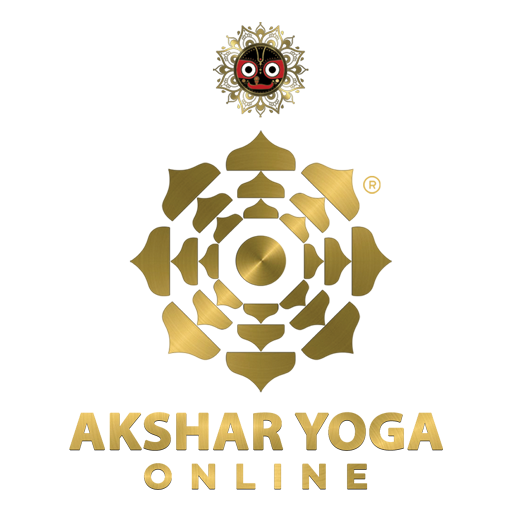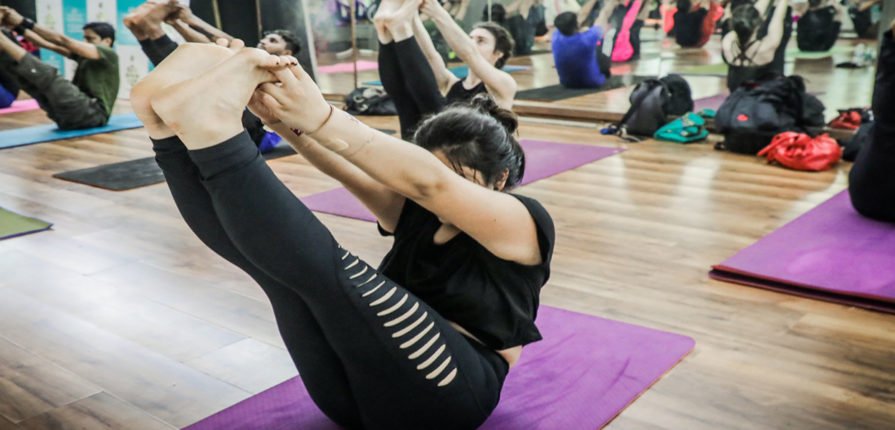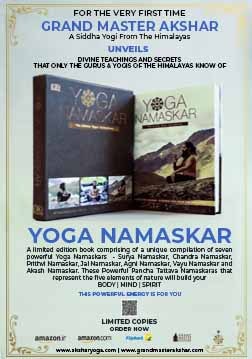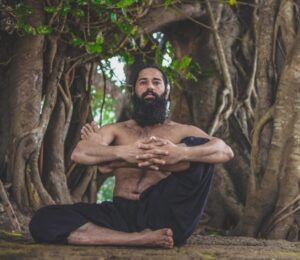Polycystic ovary syndrome (PCOS) is a condition that affects a woman’s hormone levels.Italian physician Antonio Vallisneri first described its symptoms in 1721. Statistics show that upto 10 million women in the world suffer from PCOS.PCOS is a “syndrome,” or group of symptoms that affects the ovaries and ovulation. Its three main features are:
- Cysts in the ovaries
- High levels of male hormones
- Irregular or skipped periods
- PCOS is one of the leading causes of infertility in women
PCOS also causes hair growth on the face and body, and baldness. And it can contribute to long-term health problems like diabetes and heart disease.Genes, insulin resistance, and inflammation have all been linked to excess androgen production.
Benefits of Yoga
- Pranayama (breathwork) and the meditation techniques of yoga, help to calm the mind and reach a state of deep relaxation. This leads to a decrease of stress hormones like cortisol and a regulation of hormonal imbalance.
- Yoga calms and relieves tension in the body, which in turn calms the mind. This again leads to a regulation of hormonal imbalance.
- The regulation of hormones plus the physical activity of yoga, helps to decrease weight gain.
- Yoga can help to balance out glucose metabolism and blood lipid levels
- The weight bearing poses of yoga help to increase muscle mass. This increase of muscle mass helps to combat the insulin resistance that often comes along with PCOS. Also, an increase in muscle mass leads to a higher calorie burn at rest, aiding in weight loss.
- Certain types of yoga get the heart rate up, increasing calorie burn and aiding in weight loss.
Yoga Poses for PCOS
Establish a consistent practice routine 3 to 5 times a week to fully experience the benefits of the postures.
Child’s Pose
- Child’s Pose helps to calms the central nervous system, and relieve lower back tension and menstrual cramps.
- Begin in a tabletop position on your hands and knees.
- Take your knees out wide towards the edges of your yoga mat. Bring your big toes together to touch.
- Slowly walk your hands back and lower your hips onto your heels. Then, walk your hands towards the top of your mat and lower your chest and forehead down. Hold for 8 slow Ujjayi breaths.
To practice Ujjayi breathing: Seal your lips closed and place the tip of your tongue on the roof of your mouth. Begin to breathe slowly in and out of the nose.
Cat Cow
Formation
- Begin in a table-top position on your hands and knees with a neutral spine. Draw your navel up and in to engage your abs.
- Inhale and lower your belly towards the floor for Cow Pose. Hug your shoulders down your back and tilt your tailbone up. Keep your gaze down over your nose and maintain a long neck.
- Then, exhale to round your spine for Cat Pose. Draw your belly up and gaze towards your navel. Continue alternating between Cow and Cat for 8 rounds of breath.
Benefits:
- Stimulates the central nervous system and loosens muscles around the spine.
- Massages and stimulate the abdomen and reproductive organs.
BaddhaKonasana
Formation
- Begin in a seat on the floor. Bend your knees and place your feet flat on the floor.
- Walk your feet together to touch. Then, let your knees fall out to the sides.
- Sit up tall and place your thumbs on the arches of your feet. You should feel the hips release. If you want to feel more sensation, you can press your thighs open further with your elbows. Hold for 8 breaths.
Benefits
- BaddhaKonasana helps to relieve tension in the lower back and open up the pelvic region. It also helps to reduce tension and relieve menstrual pain.
Seated Figure 4
Formation
- Start seated on the floor. Straighten your right leg out in front of you. Bend your left knee and place your left foot on top of your right thigh directly above your knee.
- Sit up tall and breathe into your left hip. Then, with a long spine, slowly walk your hands forward to fold your torso over your left foot and your right thigh.
- Hold for 8 breaths. Then, slowly rise up and switch sides.
Benefits
- Alleviates tension in the hips and lower back. It also helps to promote alignment of the reproductive organs, strengthen the ovaries, and alleviate menstrual problems.
Bharadvaja’s Twist
Formation
- To begin, sit on the floor with your knees bent and your feet on the floor. Place your hands behind you and sit up tall.
- Slowly let your knees fall to the left so that the right thigh is on top of the left foot.
- Place your right hand on the floor behind you and take an inhale to reach your left hand up. Exhale, to twist to the right, placing your left hand outside of your right thigh. Hold for 8 breaths, then switch sides.
Benefits
- Massages the digestive and reproductive organs. This pose also helps to loosen the muscles around the spine, lower blood pressure, and soothe the nervous system.
Tip: While holding this twist, use your breath to go deeper. With your inhales, sit up taller to lengthen your spine. With your exhales, twist a bit deeper.
Cobra Pose
Formation
- Begin lying on the floor face down. Take your forehead to your mat and have your legs going long down the mat behind you.
- Place your hands on the mat in line with your ribs. Engage your abs.
- Inhale to press through your palms and slowly peel your head and chest off the mat. If your lower back is tight you may only come up a few inches. If your lower back is more open, press up until you have just a slight bend in the elbow. Make sure you can keep your shoulder down your back and away from your ears. Keep your abs engaged to protect your spine. Hold for 5 breaths and then slowly release.
Benefits
- This pose applies gentle pressure to the stomach and helps stimulate the functions of the ovary.
PrasaritaPadottanasana
Formation
- Stand with your feet out wide. Point both feet forward so that they are parallel to one another.
- Bend your knees gently and slowly fold forward with a flat back.
- Place your hands on the mat. Let your head and shoulders hang heavy and shift your weight towards the balls of your feet. Feel your spine lengthen. Hold for 8 breaths.
Benefits
- PrasaritaPadottanasana increases blood circulation to the ovaries while relieving tension in the hips and lower back.
Tip: Keep your knees bent generously if you have lower back tightness.
Malasana
Formation
- Begin standing with your feet out a little wider than hips-width distance. Turn your toes to point out at 45 degree angles and place your palms together in front of your chest.
- On an exhale, bend your knees to slowly lower your hips towards the ground.
- Once your hips are a few inches above the ground, use your upper arms to press your thighs open. Simultaneously, squeeze the thighs inwards so that you feel a lift through the hips. Lift your chest into the backs of your thumbs and squeeze your shoulders down your back. Hold for 8 breaths.
Benefits
- Malasana strengthens the core and the pelvic floor. It also helps to relieve tension in the hips.
Bridge Pose
Formation
- Begin by lying on your back with your knees bent and your feet on the ground. Place your arms down alongside your body with your palms face down. Keep your feet hip-width distance and walk them close to your body.
- Press your palms into the ground as you exhale and lift your hips up towards the ceiling.
- Stay active through the inner thighs and squeeze your glutes and abs. Hold for 8 Ujjayi breaths, then slowly roll back down to your back one vertebrae at a time.
Benefits
- Bridge Pose strengthens the core and pelvic muscles, stimulating your immune and endocrine systems.
Corpse Pose
- Corpse Pose is the ultimate relaxation pose. It allows you to completely relax, balancing out stress hormones.
- Begin lying down on the floor.
- Straighten your legs long down the mat and bring your feet out wide. Let your toes fall outward.
- Bring your arms down alongside your body with your palms face up. Close your eyes and take a few deep breaths. Then, find a natural breath and allow your mind and body to relax. Hold this pose for 3-5 minutes.
Pranayama Technique
Alternate Nostril Breathing (AnulomVilom)
This pranayama technique is extremely beneficial for calming the mind, increasing parasympathetic (rest and digest) activity, and balancing the energy channels.
- Begin in a comfortable seat. You can kneel down with your hips back on your heels or sit in a cross-legged position. Place your left hand down to rest on your left thigh. Bend your right elbow and place your index finger and middle finger between your brows. Place your thumb over your right nostril and your ring finger over your left nostril.
- Plug your right nostril with your thumb and take a slow inhale through your left nostril. Pause at the top of your inhale. Then, plug your left nostril and take a slow exhale through your right nostril. Pause at the end of your exhale.
- Inhale through your right nostril. Pause at the top of your inhale. Then, plug your right nostril and exhale through your left nostril. Pause at the end of your exhale. Inhale through your left nostril, then exhale through your right. Close your eyes and continue this breathing for 3 minutes.
- For the remainder of the routine, you will cultivate an Ujjayi breath to continue to help slow the Parasympathetic Nervous System.





